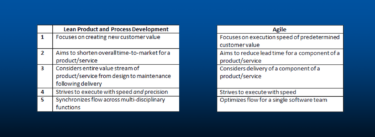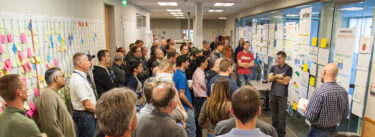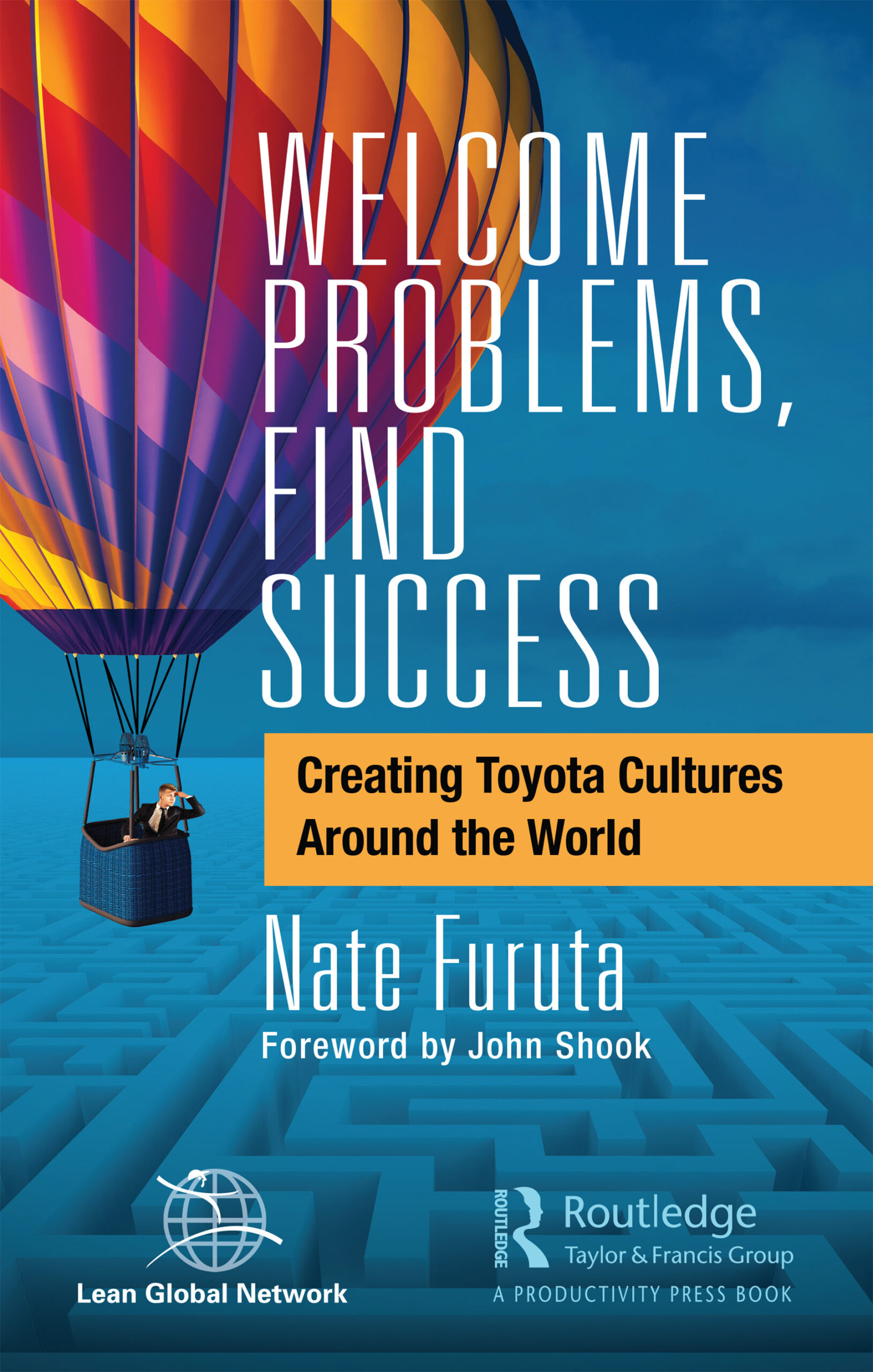Be among the first to get the latest insights from LEI’s Lean Product and Process Development (LPPD) thought leaders and practitioners. This article was delivered to subscribers of The Design Brief, LEI’s newsletter devoted to improving organizations’ innovation capability. It is the third of four in a series focused on craftsmanship or the pursuit of perfection in products and people. Craftsmanship embodies simple elegance, precise execution, and a deep, personal connection to work that transforms both the creation and the creator.
More than 1,000 engineers were at work in the design office at the Mossville, IL, engine facility of Caterpillar Tractor Company, now Caterpillar, Inc. when I walked into the vast space for the first time. Seated in rows of horizontally set drafting boards that stretched as far as I could see, they were designing engines for Caterpillar machines and the on-highway truck market. Electrical cords dangled from the ceiling to power the new CAD terminals that were replacing the boards used for the last five decades. The now defunct boards served as desks for the CAD terminals. As my first day on the job progressed, a haze filled the immense room; no-smoking policies had yet to arrive.
I vividly remember one other thing from that first day on the job 33 years ago. One board had no CAD terminal. It was tilted to the desired angle of its user, who had his own three-walled cubicle steps away from the chief engineer’s office. His cubicle was bare except for the tilted board, stool, ashtray, and coffee cup. No diplomas hung on the wall for self-promotion. He was always studying his drawing and thinking. Seldom did his phone ring; he just drew hour after hour. He was one of the most senior engine designers in the company. His name was Benny.
What does … craftsmanship have to do with the art of product development? I would say everything.
Benny had no direct reports, no fancy title, and no intention of learning how to use a CAD terminal. He had only two responsibilities: Create the concept design for the next engine and mentor the next generation of engineers. No new engine proceeded without his involvement. He regularly provided counsel to the chief engineers and their assistants. Benny had joined the now extinct high school apprentice program and mastered his trade over the next five decades. He was the first true craftsman I would meet in the world of product development.
Benny was a craftsman, not because he worked the old-school way with drafting table and pencil but because of his perseverance to gain deep knowledge, dedication to the science and art of design, and willingness to mentor the next generation of designers. These qualities, fused with the company’s commitment to retaining that deep knowledge, made Benny a competitive advantage.
What does being a craftsman and craftsmanship have to do with the art of product development? Reflecting on more than three decades in the engineering profession, I would say everything. Without craftsman, product development becomes an exercise of countless iterations in relearning and seeking what seems natural to the craftsman. Craftsman in the world of product development is not a title assigned but rather attained. Craftsmanship, therefore, is a standard of excellence sought by many but all too often not attained.
How to grow more “Bennies”
Is there a recipe for craftsmanship? What are the ingredients that make a person a craftsman (craftsperson)? The answer is simple – patience and perseverance. Patience from the organization to plant many seeds and perseverance from the individual to learn and grow. While Benny was near the end of his career and not willing to learn CAD, he was always seeking more knowledge that would expand the options for engine design.
Benny taught an engine design class every year. Getting in was competitive because you had to demonstrate the potential to become a craftsman. Throughout his career, Benny mentored hundreds of engineers. Most did not have the grit to stick with it and, gradually, the company made it difficult to stick with it. Becoming a craftsman requires that people dedicate themselves to both the science and art of design. There are many ways to design a solution but typically only one elegant solution yields the best combination of performance, quality, and cost.
Craftsmanship requires a deep understanding of the product being developed and the processes necessary to build it. In a complex system like an engine or a machine, hundreds of components work together to create a product the customer will value enough to buy. In the early days of companies like Caterpillar, Deere, and many of the automakers, the Original Equipment Manufacturer (OEM) not only assembled the final product but also built most of the pieces it needed. They designed and made engines, transmissions, axles, gears, and even hoses. This ecosystem – internal or close by — fostered a deep understanding of each part of the machine or engine.
For example, the Mossville factory machined blocks, heads, and crankshafts. An hour’s drive away, a foundry cast the parts. In another direction, a plant built the fuel systems. Just 25 minutes away, another plant made transmissions and many of its parts for Caterpillar. Moving downstream, I could drive to the assembly factory installing components into bulldozers, motor graders, or haul trucks. A product developer, in my case an engineer, had access to 90 percent of the value stream. That was more than 30 years ago. Today, those same trips would consume weeks and require a passport.
This was fertile ground to grow craftsmen. People like Benny were not the only mentors. I had access to people on the factory floor who were happy to give me their thoughts, especially when my design was not what it should be. Early in my days as a designer, I was called to the engine line. “Show me how to install your new part,” challenged the zone leader. “Well, it’s easy. It goes like this,” I confidently stated as I began to demonstrate. “Uh-oh. I guess it is not so easy,” I humbly admitted.
From that point on, I spent time on the floor talking to the people building or assembling my parts long before I completed my designs. You see, many of these people were craftsmen themselves. They had insights from years of experience assembling or machining things that could make me a better engineer. I only had to be open to learning from anyone willing to share their wisdom.
Respect your company’s “oak trees”
So, where are all the craftsmen today? Unfortunately, in the US most have retired or soon will. These are people who benefited from the proximity of the supply chain (value stream) through countless design cycles. As I said, it takes grit and perseverance to become a craftsman.
Furthermore, the financial rewards along the way are challenging and often frustrating for the individual. Too often rewards are based on hitting dates irrespective of the quality of the design. Post-launch rework has become commonplace as customers shake out the designs rather than the company doing things right during development. The value placed on a designer in pursuit of becoming a craftsman is outpaced by the person who manages people. This is not a knock on the challenges associated with managing people. However, the difficulty in measuring the value of an expert is challenging for most HR systems. Things like span of control and managed budget beat out deep expertise.
A wise man once told me the best time to plant a tree was 30 years ago and the second-best time is today. In my company, we called our senior most people “oak trees.” This was a respectful way to recognize the vast knowledge they had developed. We need to start planting oak trees.
As I studied companies with the most respect for developing and retaining knowledge, I discovered three common threads:
- Learn: They make things, so they deeply understand the trade-offs in the design and manufacture of components.
- Reward: They invest in people, so they can retain deep expertise.
- Sow: They teach the next generation, so they can nurture and grow knowledge
Learn
As mentioned, OEMs made components for their machines and automobiles. Over time, suppliers secured this role as they developed world-class capabilities. Many of the experts in design and manufacturing supported the migration of components from in-house factories to external suppliers. At this point, a company must decide how to remain relevant in the component’s value stream.
Some companies chose to continue designing but let someone else do manufacturing. This requires a close learning relationship to ensure that the product design and process design happen concurrently. Other companies decide that investing in deep expertise in both design and manufacturing is no longer required and divest both elements to the supply base.
This is a slippery slope. Over time, anyone inside the company who knows anything about the component moves or retires. This is not a digital kill switch, but a slow loss of lessons learned — a silent killer. Losing a deep understanding of component trade-offs — for a transmission, sheet metal stamping, or any product — leads to the demise of craftsmanship unless the company maintains some level of competency through prototype manufacturing cells, deep collaboration with suppliers, or retention of manufacturing capacity for a portion of the portfolio.
The decision-makers who jettisoned the deep learning and capabilities are seldom around when the magnitude of craftmanship’s demise hits.
This requires learning by company leadership through to the board of directors, all of whom must develop a thorough understanding of the value stream. Cost pressure creates the illusion that it is better to outsource rather than retain learning inherent in talent and capability. But the lesson companies continually re-learn is that it is far less expensive to maintain a capability to understand the trade-offs than it is to discount the knowledge and then re-learn it to fix quality issues in the field, which can quickly erode cost savings. The decision-makers who jettisoned the deep learning and capabilities are seldom around when the magnitude of craftmanship’s demise hits. No company seems immune to this as highly publicized quality issues have struck the most iconic companies like Boeing, Ford, Caterpillar, and even Toyota.
Reward
An old adage says that what gets measured gets done. A close corollary is what gets rewarded gets repeated. In my experience, I witnessed job hopping rewarded. Job hopping is when someone moves to get more money before learning and repaying the company with experience in the job. It became easier to get more money by moving to a new area than by building knowledge within a selected discipline.
I saw an HR policy that required a move outside of your current department to receive a promotion. HR relegated to slower salary grade growth and advancement people who wanted to develop deep expertise within a particular component.
“He’s just a tractor guy, we can’t promote him any further,” I heard my boss exclaim. Throughout my time in management, I heard this phrase repeatedly, albeit with different disciplines, e.g., engine, wheel loader, electronics, etc. My view was that was exactly why the individual should climb further in the organization. Unfortunately, that is not the conventional wisdom of management in top corporations these days. Terms like “pigeonholed” and “siloed” describe people who have become craftsmen of their profession.
However, the same managers who dismissed the benefit of deep expertise recognized these individuals when a significant quality escape subjected the company to high warranty exposure and eroding market share. The lesson is that we want the expertise, but we do not want to pay for it until there is an emergency. Obviously, this is an impossible contradiction to explain or manage.
Thus, when a company decides to outsource a component, it must put lots of resources into the relationship with the supplier or suppliers responsible for the part. Investment in personnel who will work hand in hand with suppliers to maintain an understanding of the trade-offs of the part’s design and manufacture is vital to the lifeblood of the part.
A simple example is Caterpillar bolts. For decades, these bolts were regarded as the best in the machinery industry. Even people who maintained their own equipment would go to the Caterpillar dealer just to buy bolts, a simple component that one would think was commoditized years ago. However, this is an example of a company decision that was then followed through with investment in people who could retain knowledge to ensure a deep understanding of the materials, heat treatment, and coatings that make a bolt qualified to have the Caterpillar trademark stamped on its head.
Sow
A man reaps what he sows: Galatians 6:7, New International Version Bible.A company reaps what it sows. Obviously, the opposite is also true. If one does not sow, there is nothing to reap.
While managing the Caterpillar Hydraulic Excavator Design Center in Akashi, Japan, I witnessed the process of sowing and reaping. It was common practice to hire an equal amount of manufacturing and design engineers. Manufacturing engineers filled operations and purchasing roles. Design engineers flourished in the world of design, development, and testing.
Craftsmanship is a level of excellence that should be sought as a competitive advantage.
To nurture a deep understanding across disciplines, component teams combined manufacturing, purchasing, and design people focused on a particular part of the machine. For example, heavy structures, hydraulics, powertrain, and electronics had component teams. This practice ensured concurrent design of both the product and the process. Furthermore, a high percentage of the parts were either made in-house or manufactured by suppliers within a day’s reach of the factory. The proximity allowed continuous interaction with suppliers both from an operations and a development perspective.
Another key element foundational to the center’s success was consistent hiring. The number went up and down annually, but the center hired college interns and graduates every year. This was necessary for many reasons. The most important was the circle of life. New engineers coming into the business required training. The center assigned each new engineer a mentor and a project. Technical leaders taught classes to link the key principles by discipline to the development of the product, excavators in this case. Even in difficult times, new people were brought in, perhaps in smaller numbers, allowing the people development process to continue.
This experience was 25 years after my first interaction with Benny in the engine world. Not every engineer would ultimately become a craftsman. However, the process of developing engineers sharpened both teachers and students. The process taught what craftsmanship looked like and gave individuals the knowledge needed to be better and the opportunity to choose to become excellent.
Final thoughts
Craftsmanship is a level of excellence that companies should seek as an internal capability because it’s a competitive advantage. It can’t be bought in an emergency. True craftsmanship is at the core of the best companies even though, at times, it seems to be smothered by market pressure and the tyranny of the urgent. When a company gives the technical community the accountability and associated investment to nurture the art of development, craftsmanship will emerge.
Download the latest issue of the Design Brief
Designing the Future
An Introduction to Lean Product and Process Development.








